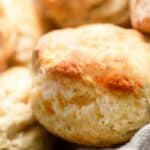Homemade Buttermilk Biscuits
Soft and buttery homemade biscuits with plenty of flaky layers! Made with simple ingredients and ready to serve in just 30 minutes.
Servings 10
Calories 275
Ingredients
- 2½ cups unbleached all-purpose flour plus more for work surface
- 1 tablespoon baking powder
- ¾ teaspoon baking soda
- 1 teaspoon salt
- 1 tablespoon sugar
- 12 tablespoons butter (1 ½ sticks) cold, cubed or sliced
- 1 cup buttermilk cold & shaken
- 1 large egg cold
For The Egg Wash
- 1 egg
- 1 tablespoon water
Instructions
- Preheat oven to 425°F/218°C Line a baking sheet with a silicone baking mat or parchment paper.
- Place the flour, baking powder, baking soda, and salt in the bowl and mix until combined.
- Cut in the butter using your fingers, pastry cutter, or food processor until the butter is coated and forms small, pea sized pieces.
- Rub mixture between your palms to to flatten the butter into the flour mixture. This helps to create super flaky biscuits. Once you feel that all the butter pieces are flattened, you can move onto your liquids.
- In a separate small bowl, combine the buttermilk and egg and beat lightly.
- Make a well in the flour mixture, pour in the buttermilk mixture, and gently mix until the mixture is just combined.
- Dump the mixture out onto a well-floured board. This dough should be fairly moist and may be sticky, but you should certainly be able to work it with floured hands. Have extra flour handy and use it often to flour your hands and work surface.
- Bring the mixture together with well floured hands. Then gently press to form a 10-inch rectangle. Using a pastry scraper, or your hands, fold one side into the center, then the other side (See photos in the post for a visual).
- Rotate the dough horizontally and gently form it back into a 10-inch, rectangle. Repeat the same folding technique two more times.
- Roll or press the dough out to an inch thick and about 10 inches long. Using a 2½ to 3 inch round cutter to cut out biscuits into rounds or you can use a knife, cut into 2½ inch squares.
- Gather the scraps and repeat the process until you use all of the dough. You should have about 8 to10 biscuits.
- Transfer to a sheet pan lined with baking paper. Whisk the egg and water together for the egg wash. Brush the tops with the egg wash, and bake for 15 to 20 minutes or until tops are golden brown.
Notes
- Be sure to check the dates on your baking powder and baking soda. Expired leveling agents will may not give you the rise you are looking for.
- Cold ingredients are essential for fluffy biscuits, warm, fat will melt quicker when baked and make them dense and greasy.
- Keep butter as cold as possible until you are ready to use it. I recommend placing the sliced butter in the freezer for 15 minutes before you start.
- Try not to overmix your dough, overmixing can cause a dense, hard biscuit.
- Use a lightweight rolling pin when rolling out your dough. A heavy rolling can flatten the dough too much. If your rolling pin is heavy, try just using your hands to press down the dough instead.
- When baking the biscuits arrange them close together on the baking tray. The biscuits will cling to each other and rise up together rather than spread and flatten.
- To use a cast iron skillet, use a 10-inch cast iron skillet lined with greased baking paper.
- For an added indulgence, brush your biscuits with melted butter when they come out of the oven.
Nutrition
Calories: 275 | Carbohydrates: 27g | Protein: 6g | Fat: 16g | Saturated Fat: 10g | Polyunsaturated Fat: 1g | Monounsaturated Fat: 4g | Trans Fat: 1g | Cholesterol: 73mg | Sodium: 487mg | Potassium: 219mg | Fiber: 1g | Sugar: 3g | Vitamin A: 527IU | Calcium: 107mg | Iron: 2mg
